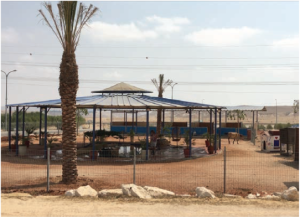DESERT SHANTI HOUSE
VILLAGE FOR AT-RISK YOUTH EDUCATION CENTER
In 2001, Mariuma Ben Yosef initiated the establishment of the Desert Shanti House
project – a therapeutic village that is based on the model of Shanti House in Tel
Aviv, with the goal of providing a solution for youths in southern Israel, and to help
expand the therapeutic tools used by Shanti House – continuing to realize the vision of
extending treatment for youths at risk in Israel and in the Negev communities.
In Israel there are currently 330,000 children and youths at risk, 14,000 of them facing danger and living in the street. Currently, 112,000 youths aged 14 to 21 living in the south, 28,000 of them are defined as being at high risk. There are five institutions for homeless youths in Israel, including Tel Aviv Shanti House.
Desert Shanti House was inaugurated in an official and dignified ceremony in November 23rd, 2009 – Ben Gurion Day – which was attended by Israel’s President Mr. Shimon Peres at the time, and the former Minister of Welfare and Social Services Mr. Yitzhak Herzog.
The village constitutes a first of its kind model in Israel and throughout the world, and every year addresses the needs of 1000 youths at risk from all corners of the country, especially southern Israel.
The Shanti House village is located on Road 40, midway between Sde Boker and
Mitzpe Ramon. It extends over 540 dunams (54 hectares), 150 of which are built up.
At any given time, residing in the village are 35 to 50 youths, aged 14 to 21 who were forced to leave their homes due to physical, verbal, sexual or emotional violence, abuse, neglect, etc. It is important to note that the Ministry of transportation, Negev Galilee Bureau, and other contributors have all joined in to make this dream a reality.
The desert and nature are central motifs in the therapeutic techniques offered to the youths, and despite its location, Shanti House residents have easy access to schools, hospitals, community services and youth employment.
In the Village’s construction, great emphasis was placed on green building, use of environment-friendly materials, water recycling, and the capability to utilize solar power. It offers youth an exceptional opportunity for rehabilitation and growth. The desert permits the development and application of innovative treatment methods uch as a therapeutic horse ranch, agricultural therapy, hydrotherapy, involvement in the Village’s social activities and no less importantly connection to the developing community of the South and contributing back to the community. The Desert Shanti House, which was designed by Mariuma, is breathtakingly beautiful, colorful and combines Mexican and Moroccan design, providing youths with a warm, esthetic welcome, that is respectful and creates a pleasant sense of relaxation.
Thousands of youths are at immediate risk. For them, the Desert Shanti House Youth Village is a last resort and a onetime opportunity for rehabilitation and the establishment of a new life before succumbing to street life.
Desert Shanti House emphasizes participation in social programs, bonding with the developing community in the south as well as giving back to the community. This is a project of national value, since its contribution to southern Israel in general, and the Negev in particular, is immense. The establishment of the village is an expression of values, such as Zionism, pioneering, caring and a burning desire to change the face and the future of the state Israel.
GOALS OF THE DESERT SHANTI VILLAGE FOR AT-RISK YOUTH EDUCATION CENTER:
- Item Realization of a dream and introduction of the Negev to youth and students from Israel and all over the world.1
- Spreading the Shanti House method
- Providing a platform for additional methods of educating against drugs, alcohol and violence
- Hosting lecturers in the fields of education, welfare and philosophy from Israel and overseas
- Teaching about contribution to the community in Israeli society
- Connecting the diaspora to Israel
- Aspiring to attaining economic independence for the village
- Creating workplaces for youths and residents of the south
- Creating workplaces for youths and residents of the south

